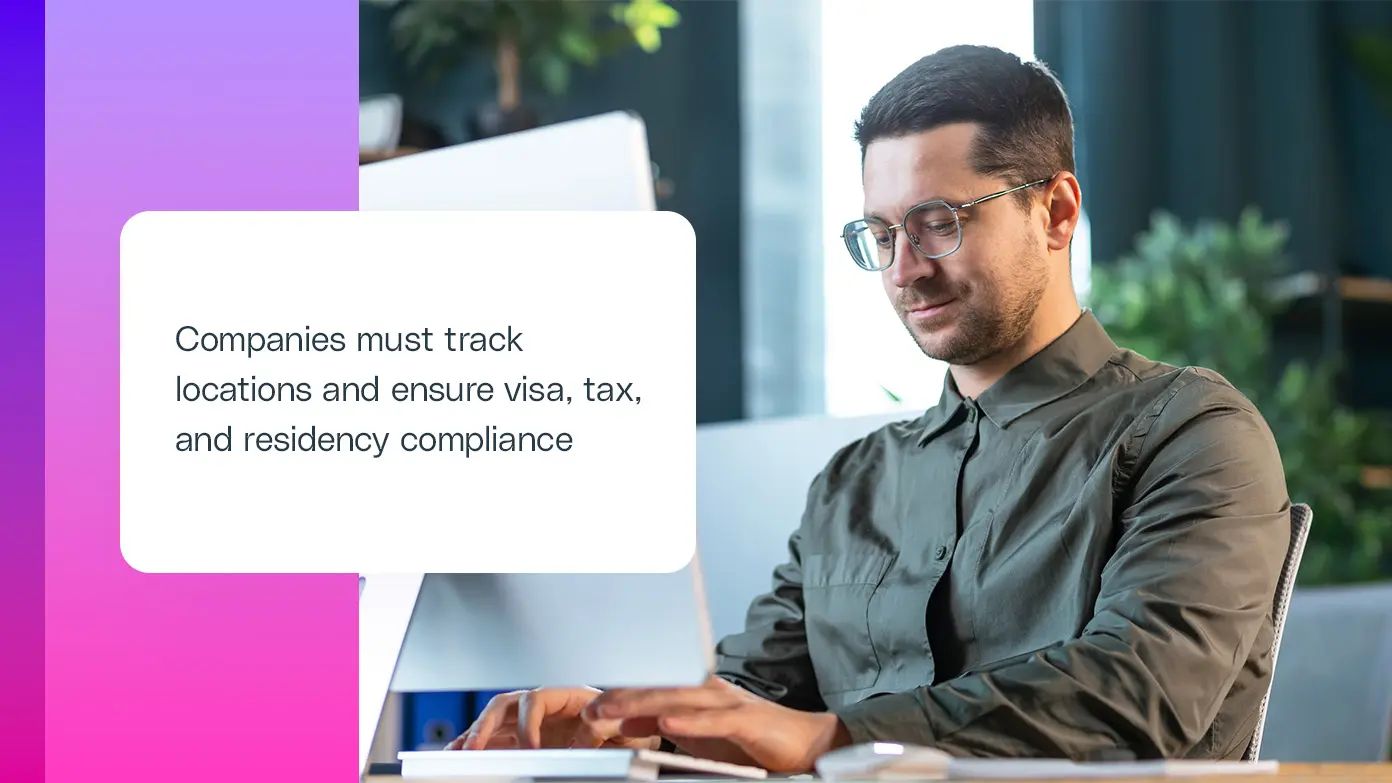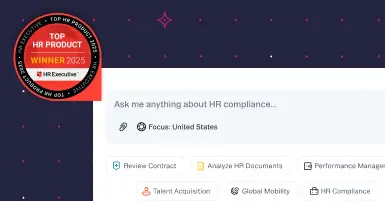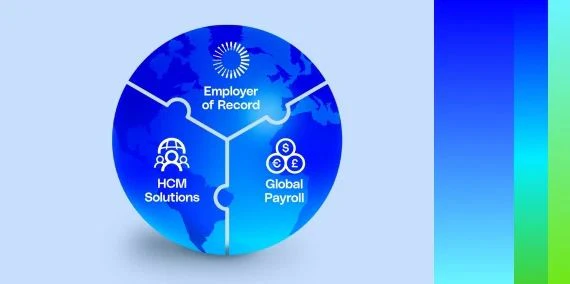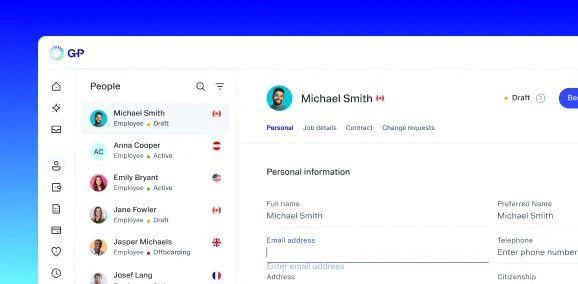Remote, hybrid, and digitized workforces are more common than ever. Employees aren’t bound by the four walls of an office anymore. Now, they work from anywhere.
Organizations need a global mobility strategy to manage their dispersed workforce effectively and compliantly. This blog explains how you can craft your own global mobility strategy to unlock the potential of the everywhere workforce.
What is global mobility?
Global mobility is the ability to relocate employees internationally for temporary or permanent roles. It includes:
-
Short-term assignments that last a few months
-
Long-term assignments
-
Occasional business travel
-
Permanent transfers
-
Remote work from digital nomads
These arrangements need thorough planning and require managing immigration, complying with local labor laws, and supporting employees. For example, your company must process work permits and ensure employees have the right visas. Your company also has to figure out the appropriate tax withholdings and mandatory benefits for permanent relocations.
What is a global mobility strategy?
A global mobility strategy is a comprehensive plan for managing employees relocating to other regions. Your HR, legal, finance, and administrative teams must work together to align your mobility strategy with your business plan, workplace values, and corporate vision. No two global mobility strategies will be the same, but here’s how you can increase your chances of success:
-
Involve relevant global mobility consultants and team leaders in the planning process.
-
Review key considerations for each employee.
-
Develop detailed workflows.
Use employer of record (EOR) solutions to streamline the process.
Benefits of global mobility
Although relocation needs planning and investment, these global mobility benefits make it worth it:
1. Can be more cost-effective
Relocating can be more cost-effective than hiring new employees. You save on onboarding and training costs, while focusing on your core business operations and growth strategies.
Managing expenses is a huge concern when implementing new programs. Proper planning optimizes your budget and avoids unforeseen expenses, such as noncompliance penalties.
2. Increases productivity and problem-solving
Flexible work arrangements often improve work-life balance. Employees can skip the commute and manage their job and personal life on their own terms.
Remote work also benefits companies. It lets you hire diverse talent from anywhere in the world. Having a team with different backgrounds provides diverse perspectives that improve problem-solving and spark creativity.
3. Improves talent retention
Turnover is costly. When team members quit, you lose valuable knowledge and disrupt team dynamics. According to Gallup, one in two employees in the U.S. is open to leaving their job. The main reasons are:
-
Pay and benefits
-
Personal reasons
-
Relocation
Relocation is one of the top reasons why employees consider leaving their jobs. With global mobility, you can retain top talent and adapt to employees’ changing needs.
For example, an employee may want to live and work closer to family. Another may need to move for health reasons. With relocation benefits, these employees can continue working for you, regardless of location.
Global mobility also improves employees’ skills. Employees who become global leaders are exposed to different markets, which improves their adaptability, resilience, and emotional intelligence. These incentives can increase job satisfaction, ultimately improving employee retention.
4. Provides valuable data and market insights
Long-term assignments immerse employees in a different culture. This can give you first-hand insights into local business practices to improve your products and services. Relocated employees can also transfer critical knowledge to local hires. This exchange is essential for your company to adapt to new markets.
When scaling globally, a one-size-fits-all approach isn’t enough. You need to understand local consumer behaviors when tailoring your menus or curating your marketing. Employees you deploy locally can bring such insights and contribute to your company’s long-term success.
5. Strengthens employer brand and global reputation
Adopting borderless, remote-first strategies improves your brand’s attractiveness to job seekers. The 2025 Global Workforce Trends found that 81% of employees prefer to work at a global company for the following reasons:
-
85% for career growth opportunities
-
66% for better pay and benefits
-
50% for skills improvement
-
40% for exposure to a greater diversity of thought
-
38% for stability amidst economic ups and downs
6. Improves organizational agility and resilience
Agility is how fast your company can adapt to market changes, economic shifts, or crises. With global mobility, you can send your employees where you need them most.
Challenges of global mobility
Relocating employees internationally has pros and cons. Understanding the following global mobility challenges avoids problems down the line and streamlines processes for your HR team, administration leaders, and employees.
1. Immigration

Every country has different immigration laws. Keep accurate records of your employees and their locations to support visa, tax, and residency needs. Regularly review the policies for granting remote work visas and living arrangements in every country of operation. Set clear expectations for visa applications, housing, and ongoing compliance. Some responsibilities fall on you, while others are the employee’s.
2. Tax requirements and compliance
When operating with employees internationally, your employment obligations extend beyond your home country. These include:
-
Relocation tax
-
Income tax
-
Social security regulations
-
Payroll compliance
-
Reporting needs
-
International pension arrangements
-
Residency requirements
3. Compensation
Determine how your company will pay employees living internationally and how it will differ from your local employees. Think about:
-
Exchange rates
-
Salary adjustments for relocation
-
Relocation bonuses
-
Compensation packages
-
Cost of living differences
4. Employee retention
Though employees will feel excited about their new international career opportunities, moving can be a stressful experience, especially for employees with spouses and children. Your HR team can help ensure a smooth transition by introducing flexible scheduling and asynchronous communication tools to boost employee retention.
A strong global mobility strategy that includes employee acclimation services can help your employees and their families adjust to their new surroundings.
5. Permanent establishment risk
Even if you don’t have a physical presence in another country, some activities can still trigger permanent establishment, resulting in tax obligations for your company.
Work with legal experts to understand which activities meet the permanent establishment criteria under the country’s tax laws. Your global mobility strategy should include prevention measures to manage these risks.
6. Cultural acclimation and integration
Although diverse teams encourage innovation, they also require strong leadership to bridge communication gaps and align different perspectives toward common goals. Misunderstandings and biases can hinder your company’s growth. Start by developing cross-cultural training and immersive practices to help reduce such risks.
How to create a global mobility strategy
When you’re ready to design your global mobility program, follow these steps:
1. Determine your reason for building a global mobility program
The first step to creating a global mobility strategy is identifying the program’s purpose, goals, and needs. Look at your key objectives, the problems you want to solve, and how the program will benefit your organization and employees. When you figure out the “why,” you can determine the “how.” This first step will help you properly allocate your funds, resources, time, and teams.
2. Outline your strategy design
Once you’ve outlined the purpose behind your global mobility program, you can start designing it. Think about the following aspects:
-
Talent pool growth goals
-
Target countries or markets for growth
-
Employee benefits, compensation, and healthcare
-
Travel and residential logistics
-
Mobility policies
-
Family support
-
Professional development
-
Communication
-
Training needs
-
Pricing and budget
-
Relocation incentives
After you’ve listed the elements you need to plan for, get feedback from your leadership team, and adjust your policies as needed.
3. Assemble your ideal team
Create your dream team to implement a successful global mobility program. Determine which team members are experts in their fields.
Clearly communicate the roles and responsibilities of each team member. Assess their needs and the needs of your mobile workforce. For example, if you want to grow in 10 different countries, working with an EOR can create a seamless experience.
4. Include employee well-being in the program design
A top priority in any organization is employee well-being. Employees are more likely to stick around when they feel appreciated, supported, and well-equipped to take on their new roles. By embedding employee wellness into your global mobility policies, you can enhance their experience, reduce the stress of relocating, and ensure the long-term success of your program.
5. Consider employee support systems
Global mobility brings significant life changes for employees. Think about what type of support you can offer them. Global mobility services include anything that helps employees be more productive, creative, and resilient. These services show your employees that you empathize with the change they’re taking on and want to set them up for success. Here are some global employee support services you can consider:
-
Housing
-
Health insurance
-
Emotional wellness services
-
Global banking
-
Relocation travel assistance
-
Household goods transport
-
Cross-cultural and language training
-
School search assistance for dependents
-
Airport transfers
-
Reconciling forms and extension filings
Hiring your global mobility team
Once you have your global mobility strategy, it’s time to build a team that involves all potential stakeholders. This team should include the following:
1. Legal teams
Always include your legal team when creating a new program that involves international travel or relocation. Legal counsel provides expert advice regarding compliance, taxes, and other international regulations to strengthen your global mobility strategy.
2. Global mobility consultant
Having someone on your team to serve as a single source of knowledge for global mobility is essential. Your global mobility consultant improves your strategy by:
-
Providing details about work visas and certifications
-
Helping your company connect with embassies or consulates
-
Formulating global deployment procedures
-
Crafting policy benchmarks
-
Giving ongoing support to relocating employees
3. Administrative leadership
Administrative teams make sure all essential team members are on the same page with the program. They should be present when discussing specific policies or processes for managing day-to-day global mobility operations, such as documentation workflow.
4. HR leadership
HR teams manage strategy implementations and coordinate employee needs. Their advice on employee-related processes can give you valuable insight into talent retention and development strategies and mitigate potential problems.
5. Executives or thought leaders
Other high-level executives or important organizational leaders connect your global mobility strategy to your company’s vision. These team members include anyone who provides forward-thinking ideas to drive your company’s growth internationally and help you scale in the upcoming years.
Enhance your global mobility program with G-P™
If you have global aspirations, partnering with a global employment expert like G-P can give you the compliance assurance you need to succeed.
Whether you want to enter new markets, access global talent, or relocate employees to strategic regions, we can help. With G-P EOR, you can hire, onboard, and manage talent across 180+ countries, quickly and compliantly, without setting up an entity.
Don’t just take our word for it. Jessica Teunissen, Manager of People and Culture at Cogstate, says, “Cogstate will continue to engage with the best candidates for the job regardless of geographical boundaries. Our partnership with G-P helps us attract fresh talent. G-P also allows us to support the seamless transition of our existing team members should they opt to relocate, ensuring satisfaction, ongoing professional development, and sustained growth for our organization."
If you’re ready to break down the barriers of global hiring, book a demo today.





















